
Official Edgar Rice Burroughs Tribute and Weekly Webzine Site
Since 1996 ~ Over 10,000 Webpages in Archive
Volume 1337
Men Like Gods
Tarzan Pays Homage To Heracles
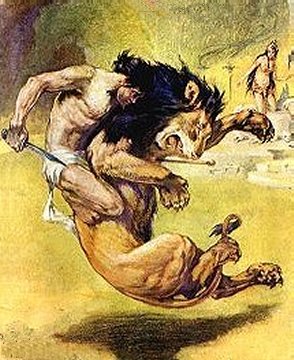
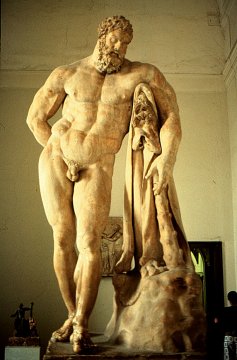
by
R.E. Prindle

Men Like Gods
Tarzan Pays Homage To Heracles


by
R.E. Prindle
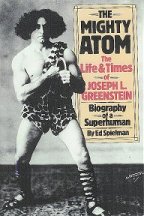 |
The Golden Age of Strongmen had captured the imagination of the world between 1890 and 1910.... Into the 1920s the strongman continued as a living wonder of the world, an awesome and inspiring vision that could be had for a modest price of admission. ~ Ed Spielman: The Mighty Atom. |
When I was a child and youth in the 1940s and '50s the legendary strongmen of the turn of the century were, if no longer living, living legends. At least one, Bernarr Macfadden, the father of American bodybuilding was still going strong.
The most legendary of the strongmen was Frederick Mueller who was known professionally as the Great Sandow.
In his heyday Sandow as so strong that he was capable of 'exploding' or breaking the 'Test Your Strength' machines at arcades in Vienna, Austria. There were so many broken machines that it was thought that a vandal was destroying them but when apprehended it was discovered that Sandow was not only testing his strength but the strength of the machines. He flippantly suggested that they be made of better materials.
On stage, as Spielman relates, Sandow, who was also trained as a turner, could do a back somersault over a chair with a thirty-five pound dumbbell in each hand. He could do a one arm chin-up with the grip of any of his fingers of either hand. including his thumbs.
He could... wait a minute! I've heard something like that before. Oh yea. I remember now, in Edgar Rice Burroughs' Tarzan And The Lion Man he has Tarzan leap up to seize stakes pointing down from a ten foot high wall, then draw himself straight up until his torso was above the stakes, then roll over the top defeating the purpose of the stakes. Was he thinking of the Great Sandow when he wrote that?
I think he was.
Burroughs was a fan of boxing and a great admirer of the strongmen of the Golden Age, although he didn't like the bulky physiques. He repeatedly denounces the physical build of the strongmen in preference for Tarzan's 'smooth rippling muscles'. In my day the bodybuilders were ridiculed as being 'muscle bound.' Tarzan is as strong or stronger than the strongmen but sleek.
Next one asks is there any place that it can be shown that Burroughs ever saw Sandow? Yes, and where else? The Chicago Columbian Exposition of 1893. The Expo was a life changing experience for 17-year-old Ed Burroughs. Bill Hillman of the ERBzine has written a wonderful series on the influence of the Fair on young Burroughs.
The influence of the Fair was as moving on the rest of America and the World as it was on Our Man. There apparently has never been so influential a World's Fair as that of Chicago of 1893.
One of the best attended features of the Fair was the show put on by the Great Sandow. Bodybuilding had already gotten started in England. Sandow was a student of the innovative Professor Attila in London. He came to the attention of Florenz Ziegfeld while performing in New York. Ziegfeld brought him to Chicago for the Expo. Sandow was a sensation.
He created quite a stir at the fair. Not only did Burroughs see him there but so did a man named Bernarr Macfadden. At the time he was known as Bernard McFadden but he chose Bernarr because it sounded more like a lion's roar and Macfadden because he thought it look more distinguished. As a result of seeing Sandow, Macfadden became the father of bodybuilding and the health movement in the United States. John Dos Passos spoofs him in Vol. III, The Big Money of his USA Trilogy.
Macfadden was the discoverer of isometric exercises which his student, Charles Atlas, renamed Dynamic Tension and made a fortune.
Unless I'm mistaken Macfadden would cross ERB's path sometime between 1908 to 1912.
Sandow made bodybuilding a rage after the Fair while Macfadden organized the sport around his magazine 'Physical Culture' which he began publishing in the wake of the Fair. Sandow also opened the way for a number of strongmen to build careers on their physiques.
They all passed through Chicago. How many of them ERB paid the modest price of admission to see we can't know, but as he always speaks of strongmen in the plural one assumes that he saw several.
Anyone who has watched the Strongest Men In The World competition on cable TV will understand how impressive both the feats and the physiques of these men are.
In ERB's day a man called Warren Travis Lincoln could lift a platform that held twenty-five men with his back. That was a weight of about 4200 pounds.
G.W. Rolandow could stack three decks of playing cards and tear them in two. One assumes that was before they were plastic coated.
Emil Knaucke who weighed in at five hundred pounds, a spectacle in itself, could hold a car above his head with one hand. Spielman doesn't specify make or model.
Louis Cy, one of the most famous strongmen, could restrain a team of horses on either side at the same time. Really spectacular stuff.
A man like Arthur Saxon of the Saxons was considered to be the strongest man in the world. He could do a bent press of nearly five hundred pounds. As in the photo, in the bent press a lifter raised a barbell above his head with one hand in a bent posture then raised another weight with his other hand.
Eighteen ninety to nineteen-ten were formative years for ERB. He would have been from fifteen to thirty-five so that when he saw Sandow in '93 at seventeen he was at a most impressionable age.
ERB turned 40 in 1915 and 50 in 1925.
By the twenties vitamins and food supplements had been discovered and were being developed for commercial use. Vitamins were still novel when I was a kid in the late forties. Not everyone knew of their value then.
The Great Sandow, Louis Cyr, and a trio of German strongmen called the Saxons were all naturally strong but by the 20s it was possible to build muscular Adonae from the scratch of a 98 lb. weakling. With vitamins, food supplements and a rigorous regimen for body building a normal body could be turned into as mammoth a specimen as Tarzan, as witness Arnold Schwarzenegger and his contemporaries who emerged from New York City gyms in the 1960s.
In point of fact you didn't even need all that gym equipment. If you followed the body building plan of the most famous Adonis of the 40s and 50s, Charles Atlas, all you needed was your own opposed muscles.
Atlas took Macfadden's isometric exercises and called them the more commercial sounding Dynamic Tension. By pitting one muscle against its opposite fantastic results could be achieved.
Charles Atlas, who changed his name from Angelo Siciliano, was voted the world's most perfectly developed man in 1922 by his mentor, Macfadden, and Physical Culture magazine.
Angel, born in 1894 in Acri, Sicily came to the US in 1904, thus he would have been 28 in 1922, 18 in 1912.
Siciliano actually had been a 98 lb. weakling who had sand kicked in his face by a bully. His girl friend actually did walk away from him. Siciliano then built himself up into what I've always considered the image of Tarzan and changed his name to Charles Atlas.
I was not as successful with the Dynamic Tension plan Chuck sold me in the '50s but then I didn't try that hard and I couldn't afford the food supplements which are indispensable. Nevertheless it had become possible to turn out 'Men Like Gods' on an assembly line basis.
It is more than likely that Burroughs was very familiar with the bodybuilding or fitness program of Macfadden. That photo of him flexing his muscles on the dock at Coldwater is that of a man who has been working out. I can't believe that a man who was interested in magazines as he was wouldn't be familiar with Physical Culture. Not only would he have the living memory of the Great Sandow in his mind from the Expo but Bernarr Macfadden moved his headquarters from Battle Creek to Chicago in 1908. He had a very prosperous looking facility.
During these years from 1899 when ERB was bashed in Toronto to 1910 he complained of excruciating headaches that began when he got up in the morning lasting through half the day. These would have been very enervating affecting his ability to work. In Girl From Farris's he has his hero Ogden Secor suffering from the same headaches going from doctor to doctor 'tinkering with his skull' in hopes of finding relief. The doctors could do nothing for Secor so he undertook a fitness regime which eased his situation. So did ERB.
Once again, the picture of ERB standing with his legs apart flexing his muscles on the dock at Coldwater in 1916 shows that he was either proud of a moderate physique or he was trying to develop those 'rippling' muscles like Tarzan and Charles Atlas.
At fifty in 1925 ERB probably thought himself beyond the age where he could develop his physique into a semblance of his creation, Tarzan. Ten or twenty years younger and you might have seen Burroughs as another Charles Atlas or Tarzan.
There is every reason to believe that sometime between 1908 and 1912 he developed an interest in Macfadden's program.
When he sat down to begin his Tarzan series at the end of 1911, Burroughs' mind must have been filled with the feats of Sandow and the other strongmen. Anent this, Tarzan's leopard skin loin cloth was borrowed from the strongmen. Leopard skin shorts were de rigeur for the bodybuilding crowd.
Of course the role models for these strongmen were Samson and Heracles. The latter is better known in his Roman usage as Hercules. For the purposes of this essay I will refer to him as Heracles in his Greek manifestation.
Especially in his original manifestation Heracles was a Sun god as the companion of the Earth Mother, Hera. When the Patriarchal system was imposed on the Matriarchy Hera was wed to Zeus while her former consort, Heracles - The Glory Of Hera - was demoted to the role of Holy Fool and the strongest man in the world.
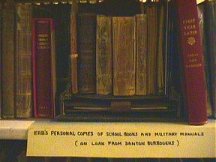
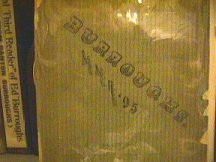
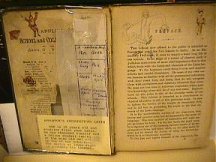
ERB often refers to Tarzan as a Jungle God and a latter day Hercules. Burroughs had a good Greek and Latin education so one might assume that he had some familiarity with the cycle of myths devoted to the feats and tribulations of that ancient type of all strongmen, Heracles.
In fact, without stretching the point unduly, one can posit a relationship between the Pelasgian sun god, Heracles, and the Flaming God of Opar and through them to Tarzan; they can be construed as one.
Whether ERB was conscious of what he had done in conflating the three cannot be determined for sure but as he was manipulating valid historical data why shouldn't he have been conscious of what he was doing? The Aztec ritual of tearing the heart out to offer to the sun god is implicit in scenes where Tarzan lies across the sacrificial block, pardon me, altar. The annual sacrifice of the queen's consort is implicit once again as La raises the sacrificial knife. A blatant resemblance to Cybele and Attis.
While the subconscious is always important it is the conscious mind which organizes, plots and writes. As a writer I may have subconscious motives which may emerge but assembling and organizing my material is a conscious act. It is axiomatic that one cannot write what one does not know.
One of the great mysteries of mythological studies has been the relationship of Heracles to his namesake the Earth Goddess, Hera. I noted just previously, during the matriarchy as the Sun, Heracles would have been appropriately called 'The Glory Of Hera' or of the Earth. The same notion can be applied to Mesopotamian and Egyptian mythology. For instance, as David Adams points out somewhere, the lion is a symbol of both the sun and the matriarchy. It is a fact that the body of the Sphinx at Memphis is older than the head. The head of the original has been replaced by that of a man. It therefore follows that the Sphinx was carved during the matriarchy having either a lion's or a woman's head. After the succession of the Patriarchy the head was changed to reflect the New Order.
In the Greek Oedipus myth the Theban Sphinx was still represented as the original matriarchal symbol of a lion with a woman's head. The answer to her riddle after which she committed suicide was 'man' which denied the Matriarchy, hence she had to kill herself. Apply that to the Egyptian Sphinx and the change of heads.
Now, the Egyptian Sphinx was exactly the same as the Theban Sphinx: a woman's head on a lion's body. The Sphinx is positioned to be looking due East at sunrise in the Age of Leo. Thus, perhaps, the 'secret' of the Sphinx is simply that as Mother Earth she sat waiting for her consort Heracles (or his Egyptian counterpart) to appear on the horizon each morning.
The notion has simplicity to recommend it.
As we all know, Oparians were a group of Atlantans isolated from the main body when mythical Atlantis broke apart and sank beneath the waves of the Atlantic Ocean. The worship of the Flaming God was inherited from the parent civilization by Opar.
Thus whether Burroughs knew what he was doing or not he always gets the sequence of events right.
Without getting into any discussion of if, where or when Atlantis may have existed let me say, nevertheless, that all the evidence points to a predecessor civilization anterior to Crete, Pelasgian Greece, Egypt and Mesopotamia in much the same way Atlantis preceded Opar.
This predecessor civilization must have existed in the Mediterranean Basin during the last ice age when ocean levels, scientists tell us, were several hundred feet lower than they are today. There are evidences of quarrying several hundred feet below sea level on the flanks of the island of Malta, for instance. Given this as a fact, then when the ice melted and the waters rose during the Great Flood to their present levels any society or civilization that existed in the Mediterranean Basin was forced to move to higher ground which is to say above the present sea level.
One thing is certain, if the Basin was habitable it was inhabited.
This disruption caused a long dark age from which mankind only slowly recovered. At the same time these relatively highly developed people moving into less developed savage societies had a fertilizing influence introducing more sophisticated ideas and methods such as agriculture.
Lower Egypt, one of the Two Lands, was obviously settled by the displaced Libyan dynasty. After centuries of warfare the Upper Egyptians succeeded in conquering Lower Egypt uniting the Two Lands. The Third Dynasty was a Libyan Dynasty. During it the great pyramids were built reflecting in some way the flooded predecessor civilization.
So Crete and Pelasgian Greece received survivors also. The Sumerians of Mesopotamia attribute their civilization to the advice of Oannes, John in English, who came from the sea.
Often ignored by classical scholars but obviously part of this great Mediterranean Culture is ancient Spain. Now, Spain has one of the great traditions of the worship of Heracles as a Sun god. This tradition preceded and was uninfluenced by any Patriarchal tradition from Greece. In point of fact the patriarchal Heracles went West to annex the Spanish traditions to the Patriarchal cause. In the process he rounded up the cattle of the Sun to bring back to Greece. Throughout history, including modern Africa, lifting another man's cattle transferred his authority to oneself. See the great cattle raid of Cooley in Irish mythology. It therefore follows that the Greek Patriarchal myths of Heracles are built on an earlier Matriarchal mythological cycle while being perverted or converted to Patriarchal needs.
Heracles was originally a sun god. He was the original of the Flaming God. I can't say Burroughs knew this either consciously or subconsciously, however as we will see there is substantial evidence to indicate that he was consciously manipulating the material.
The city of Seville is built over a Sun temple in which Heracles was the sun deity. This site beneath Seville can still be visited today. Assuming that the history of the Spanish Heracles developed independently of the Greek Heracles which after all is a Greek interpretation of the Pelasgian god then it follows that the two traditions must have come from a common source. That source cannot have been other than the ante-deluvian civilization of the Mediterranean Basin.
It follows then that whatever names they were known by in this anterior civilization Hera was the Great Mother Goddess while her 'Glory' Heracles must be no other than the Flaming God, the Sun. What else could the 'Glory' of the Earth Mother be?
Thus, when the Great Flood, which must be the same as that spoken of by the Sumerians who would have gotten the story from Oannes destroyed the civilization of the Mediterranean Basin the inhabitants fled to the former highlands surrounding them taking their traditions with them. The Spanish Heracles was yet identical to the Pelasgian and Cretan models which later became variant.
When the Greeks entered Pelasgia at the beginning of the Arien Age, the Zodiac dates back to the anterior civilization, they found this remnant of the ante-deluvian civilization with immemorial religious traditions occupying the land. As the Arien Age began a great shift in the mental and social organization of man progressed in its evolution. The shift was from a Matriarchal consciousness to a Patriarchal consciousness. In other words, the God replaced the Goddess as the most important sex. Fecundation became more important than actual reproduction.
This meant that all the divine myths had to have all the sexual relationships reversed so that the God took precedence over the goddess. Hera could no longer be allowed to have a male god as her subordinate 'Glory', the roles had to be reversed.
Homer's Iliad is one key in the story of this reversal.
As Hera was unwillingly made subordinate to her Lord and Master, Zeus, Heracles had to be appropriated by the God. The patriarchy then turned Heracles into a scourge of Hera and she his enemy in ridicule of the previous dispensation. Kind of a Burroughsian style sly joke.
The meaning of the name Heracles as the glory of Hera was thus lost. Heracles lost his identification with the Sun becoming a buffoon as the greatest of men; a physical giant of somewhat dim intelligence. Hera's glory was turned into a laughing stock but still a good sort of fellow who could aspire to godhood at death.
In the Patriarchal Greek myths Heracles destroyed various Matriarchal cult centers such as the Hydra at Lerna, the Stymphalian Swamps, the Stag of Artemis, the Nemean Lion and others. His cycle of adventures was involved in replacing the Matriarchal with the Patriarchal as the sarcastic 'Glory' of Hera.
To make a feeble Patriarchal attempt at accounting for the meaning of Heracles' name Homer tells the following story in book XIX of the Iliad. Zeus, influenced by the goddess Folly, announced to the assembled Gods on Olympus that before the day was out a descendant of his would be born to a mortal woman who would be the greatest man in the world.
Hera who hated the infidelities of Zeus, heard his proclamation with scorn. She knew her husband but too well. She knew he referred to Alcmene who was bearing Heracles but she also knew that a son was to be born to the wife of Sthenelus who was only seven months pregnant. Sthenelus was of the lineage of Zeus.
Hera rushed off to visit Eileithyia, the goddess of childbirth, to ask her to hasten the birth of Eurystheus. The latter having been born first became the greatest monarch of the age after the patriarchal fashion but by Matriarchal means.
Hastening back to Alcmene Eileithyia uncrossed her legs allowing Heracles to be the younger son of Zeus born on that day. While Heracles was the bravest and strongest of men he was nevertheless compelled by Hera's resource and prompt action to be subservient to Eurystheus. Thus the will of Zeus which could not be averted was perverted by Hera to thwart the Big Guy's will.
Heracles was still the strongest man alive but he was subordinate to the will of Hera through Eurystheus, portrayed as one of the weakest and most cowardly men of his time but by the grace of Hera and the matriarchy, the greatest ruler.
Zeus, appalled by his lapse of judgment threw Folly off Olympus from which she is still banned.
In that sardonic manner Homer explained the meaning of Heracles as the glory of Hera. She had used him to Ace Zeus.
Heracles had been stripped of his role as the glorious Sun companion of Hera. He comes down to us as the strongest man who ever lived. In the Roman nomenclature of Hercules he became the role model of every strongman who ever lifted a dumbbell. Yet they all wore leopard skin shorts, the leopard being a symbol of the Matriarchy. You can't fool Mother Nature. To Burroughs who was a student of Greek mythology the great strongmen of the Golden Age must have appeared as men like gods. Their feats of strength, their marvelous physiques were so far beyond the abilities of ordinary men that they must have seemed to be in a class by themselves far above mortal men.
In that sense Tarzan is the greatest of the strongmen, above Sandow, Arthur Saxon and even Heracles.
Heracles himself had been demoted to a mere mortal although his legend was so great that he was allowed immortality by the Patriarchy after his mortal death. Unwilling to grant him too much credit he was only allowed to be the doorman of Olympus. He held this position throughout the Arien Age being replaced by St. Peter in the New Dispensation of the Piscean Age.
Burroughs, familiar with the mythic cycle of Heracles, however he understood it, plays with both identities of Heracles in the person of Tarzan at Opar. He also brings in a number of elements from H. Rider Haggard's novel She. There can be no doubting the influence of Haggard. Burroughs even names his heroine La which is what 'She' is designated as in French translations of Haggard's novel. The palace of Opar is also based to some extent on the labyrinthine caves of She.
There are many literary influences for the creation of Tarzan not least of which are the real life H.M. Stanley and Haggard's fictional heroes, Sir Henry Curtis and Allan Quatermain. I would now like to direct attention to a third, that of the hero of She, Leo Vincey.
If one closely examines Vincey it will be discovered that he too was a Sun king whose death had been caused in an earlier incarnation by She. The cartouche which contains the name of Leo's distant Egyptian ancestor was translated as 'The Royal Son Of Ra' or son of the Sun as in Egyptian mythology Ra is the sun.
Leo also translates from the Latin as Lion so we have the Son of the Sun who also is a Lion Man which is how Burroughs refers to Tarzan in 'The Invincible' and undoubtedly as how he always thought of his creation.
Haggard translates Vincey as the Avenger. Tarzan is the 'Avenger' or guard of Africa. Haggard describes Vincey as almost inhumanly beautiful while Tarzan is the most handsome man in the world not unlike Charles Atlas.
Haggard's She is indescribably old kept forever youthful by having bathed in the fire of eternal youth. Hera was also eternally youthful and a virgin queen. She restored her youth and virginity by bathing annually in a holy spring. Hera's bath obviously refers to the Spring rains which inundate Mother Earth just prior to vegetation springing forth in virgin birth. After the summer heat the vegetation dies down and Earthy Hera becomes barren once more to await her bath and return to virginity.
So a connection can be made between Sun>Heracles>Vincey>Tarzan and Mother Nature>Hera>She>La.
Burroughs La was neither ancient nor immortal in the personal sense although she was the latest in an immortal line of Priestesses. She is a priestess of the Sun or Ra, the Flaming God.
Haggard's Leo Vincey was the direct descendant of Kallikrates She's great love of two millennia past. She, or Alyesha, to use her name, had killed Kallikrates in a rage. Kallikrates' descendants were sworn to avenge the murder. Thus Vincey travels from England to far off Africa to locate this fabulous woman.
Kallikrates was the love of Alyesha's very long life. When she recognizes Leo Vincey as her long lost love she saves his life while offering him eternal youth if he will only bathe in the flames of eternal life. He hesitates to do so. To encourage him Alyesha steps once again into the flames which was a serious miscalculation. She crumbled to dust. Thus while Leo Vincey doesn't actually avenge the death of Kallikrates She is nevertheless his victim.
Tarzan while actually born in Africa was conceived in England so he made the trip to Opar from England although he is ignorant of La. When Tarzan is captured in Opar he is laid on the altar of the Flaming God, La with the sacrificial knife raised, looks down on this Jungle God, this man like a god, and falls in love. Thus we have a replay of the She-Kallikrates situation.
Unable to take Tarzan's life, La releases him begging him for his love. Alyesha's full title was She-Who-Must-Be-Obeyed in the Matriarchal sense. The old conflict arises, Tarzan is more on the Patriarchal side, he has his moly in the waistband of his loin cloth, monogamous and we are led to believe, happily married, so the Lion Man Sun King declines the honor of being mated to La>Hera. He asserts his Patriarchal prerogative to disobey although he always has a soft spot in his heart for La.
In a fairly masterful way ERB conflates the legend of Heracles, the fiction of H. Rider Haggard and the incredible strongmen of the Golden Age and his own little bit to write a charming and beautiful story which is fairly simple on the surface but one which becomes immensely rich with a deeper understanding of the sources.
Ernest Hemingway once said that before one sat down to write one should have ten times the information in your possession as you put on paper else the story will seem shallow and contrived. It would seem that the sources upon which Burroughs was drawing, from the bodybuilding strongmen of his day to the legendary cycle of Heracles to the adventures of H.M. Stanley and the fiction of H. Rider Haggard might well fulfill Hemingway's dictum.
When one searches for the sources of Burroughs one find layer after layer of golden riches while discovering that in fact ERB did indeed create a man like a god - Tarzan the Magnificent.
This is a quote taken from Bonzo Dog's song Mr. Apollo. I don't know whether you were familiar with the Bonzos but they were one of my favorites. Several glorious LPs. Neil Innes came from them as well as the tragic Viv Stanshall. Leave those drugs alone, boys.
Follow Mr. Apollo,
Everybody knows that a healthy body
Makes a healthy mind.
Follow Mr. Apollo,
He's the strongest man the world has ever seen.If you take my his courses
He'll make you big and rough.
And you can kick the sand right back in their faces.A few years ago I was a four stone apology-
Today, I am two separate...Gorillas.Bonzo Dog Doo Dah Band. Long May They Wave.
Finis
WEB REFS
The 12 Labours of Hercules related to ERB's Jungle Tales of Tarzan by David Adams
R. E. Prindle welcomes your
comments at:
dugwarbaby@yahoo.com
|
and Follow the Navigation Chart for the Entire Series of Articles |
|
Differing viewpoints are welcome. |
|
are not necessarily those held by Edgar Rice Burroughs, Inc. |
![]()
![]()
![]()
![]()

![]()
BILL
HILLMAN
Visit
our thousands of other sites at:
BILL
AND SUE-ON HILLMAN ECLECTIC STUDIO
ERB
Text, ERB Images and Tarzan® are ©Edgar Rice Burroughs, Inc.-
All Rights Reserved.
All
Original Work ©1996-2005/2010 by Bill Hillman and/or Contributing
Authors/Owners
No
part of this web site may be reproduced without permission from the respective
owners.